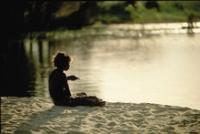To the casual observer, it's nothing special: just a broad, grassy floodplain bordering the Jordan River, on the outskirts of suburban Hobart.
For more than 40,000 years, though, it was an important meeting-place for Aboriginal tribes - a fact confirmed by archaeologists, who recently uncovered the oldest evidence of human habitation in the Southern Hemisphere.
Now the site is under threat, according to opponents of a proposed bridge across the river, which would form part of a new four-lane highway. The Tasmanian state government has resisted calls to re-route the road, and with approval for the bridge expected to be granted within weeks, conservationists have made a last-ditch appeal to the federal government to intervene.
The A$177 million ($234 million) Brighton Bypass road has been in the planning for more than 20 years, and is regarded by the Government as essential state infrastructure.
In 2008, after concerns were raised by Aboriginal groups, it commissioned a dig by the Jordan River, which unearthed an extraordinary treasure trove: an estimated three million artefacts dating back about 42,000 years.
A final report, published in August, described the site as being of "extremely high scientific significance".
The principal archaeologist, Rob Paton, wrote: "It has the potential to give us a glimpse into an unknown part of world history and the spread of Homo sapiens across the earth."
Much of the Jordan River valley was home to Aboriginal people, and three major tribal groups congregated regularly on the floodplain through the millennia. Wild cherries and other bush fruits grew in the area, which - as well as offering plentiful water and fish - was full of kangaroos and wallabies to hunt. Aborigines were still living there as late as 1828, 25 years after Europeans arrived in Tasmania.
While the ancient riverbank campground is internationally significant, it has particular meaning for present-day Tasmanian Aborigines, whose heritage and history were virtually wiped out during the brutal settlement process.
Michael Mansell, legal director of the Tasmanian Aboriginal Centre, says: "That's a place that really strikes at our heart, and is about our identity, our past and our future.
"When you stand down by that levee, you can feel the presence of our ancestors, of the old people and the children."
After visiting the area this week, the federal Infrastructure Minister, Anthony Albanese, said he would take advice on whether federal intervention was warranted. "It's very clear that this is a significant site that needs to be protected," he said.
The state government argues that the bridge will not destroy or disturb the site. But critics point to concrete pylons which will be sunk into the floodplain, and to plans to create a massive in-fill of rocks beneath the road. The two sides disagree about the width of the site, which Aboriginal activists say spans 300 metres; according to the government, it is 60 metres wide.
One of the bridge's most high-profile opponents is Andrew Wilkie, one of five federal independent MPs. Wilkie, who represents a Tasmanian electorate, has called for the site to be National Heritage-listed and appealed directly to Prime Minister Julia Gillard to protect it.
The Greens, who have one federal MP and are in coalition with Labor at state level, have also highlighted the risks posed by the highway.
Aboriginal people are prepared to blockade the riverbank and prevent the bulldozers going in, according to Mansell. During demonstrations there last year, dozens of protesters were arrested.
Conservationists - who say that the tools, stones and spear tips found next to the Jordan could rewrite Aboriginal history in Tasmania and Australia - are also awaiting the outcome of a legal challenge. The Supreme Court is to rule on whether the Tasmanian Heritage Council acted correctly when it refused to step in and protect the site.
Digging eight test pits, the archaeologists found 1440 artefacts, concluding that three million lie buried beneath the ground. "They're stone artefacts, they're used for day-to-day living, cutting and sharpening," Paton told the ABC in April. "It's that day-to-day stuff that really is rarely found.
"That's why to get a snapshot of what life was like 40,000 years ago is really quite unique, not just for Australia but for hunter-gatherer sites anywhere in the world."
Mansell accuses the state government of "cultural vandalism", saying: "We thought they would share our excitement about this discovery, but instead they just saw it as a handicap to their highway. They really have no appreciation of anything that's different from their white culture.
"To them, white heritage is sacrosanct, but Aboriginal heritage, they're happy to build straight on top of it. You wouldn't see them pouring rubble or building a bridge over the top of Port Arthur."
Little trace remains of ancient indigenous culture in Tasmania, where Aborigines were rounded up and killed or shipped to offshore islands in the early 19th century.
The Tasmanian government has examined eight alternative routes that would divert the highway away, but says none of them are viable. In addition, they would add between $80 million and $140 million to the cost of the project, it says, and would not meet safety requirements.
Writing in the Hobart Mercury in August, Norm McIlfatrick, secretary of the Department of Infrastructure, Energy and Resources, said: "It is essential that construction should proceed along the alignment originally identified during many decades of planning and design work."
To that, Mansell responds that the artefacts only came to light two years ago.

